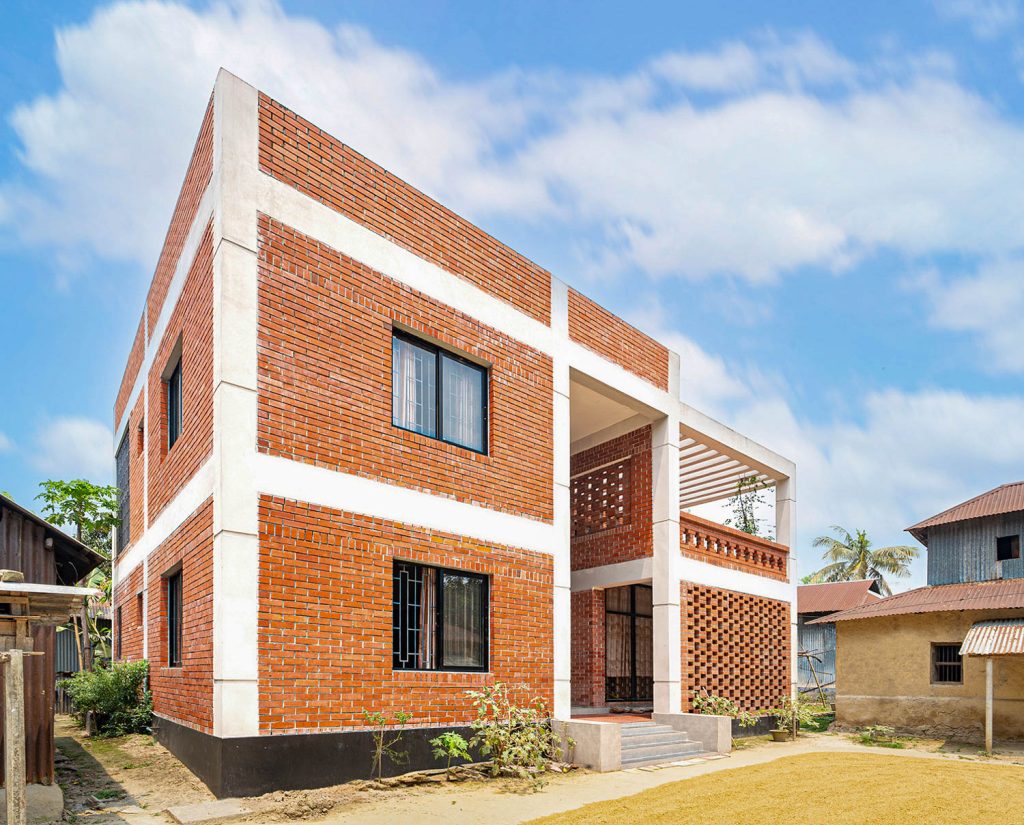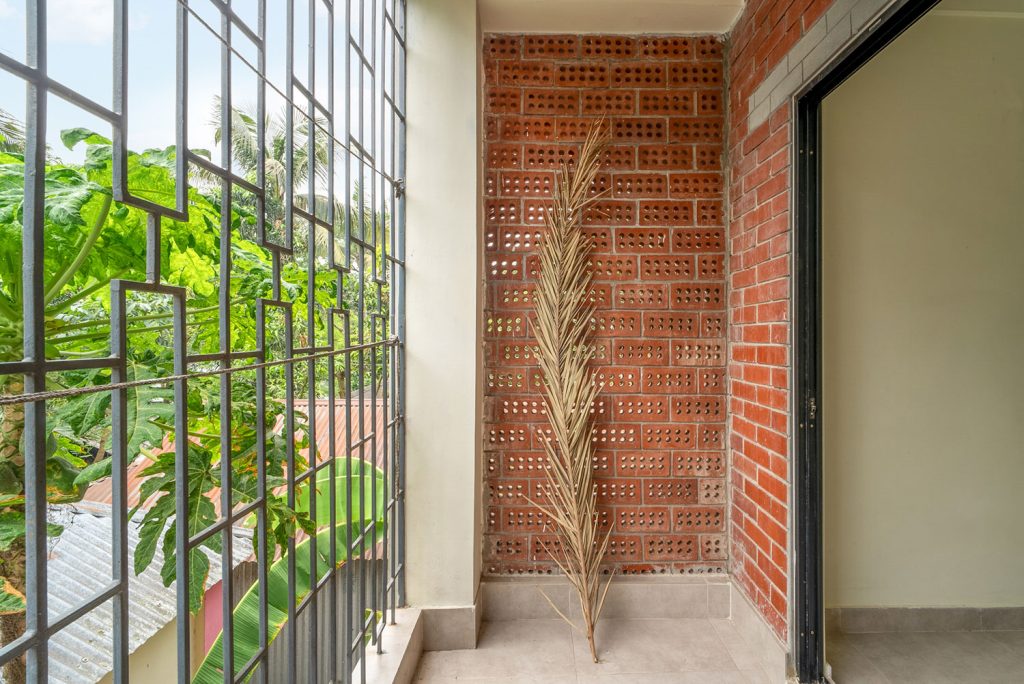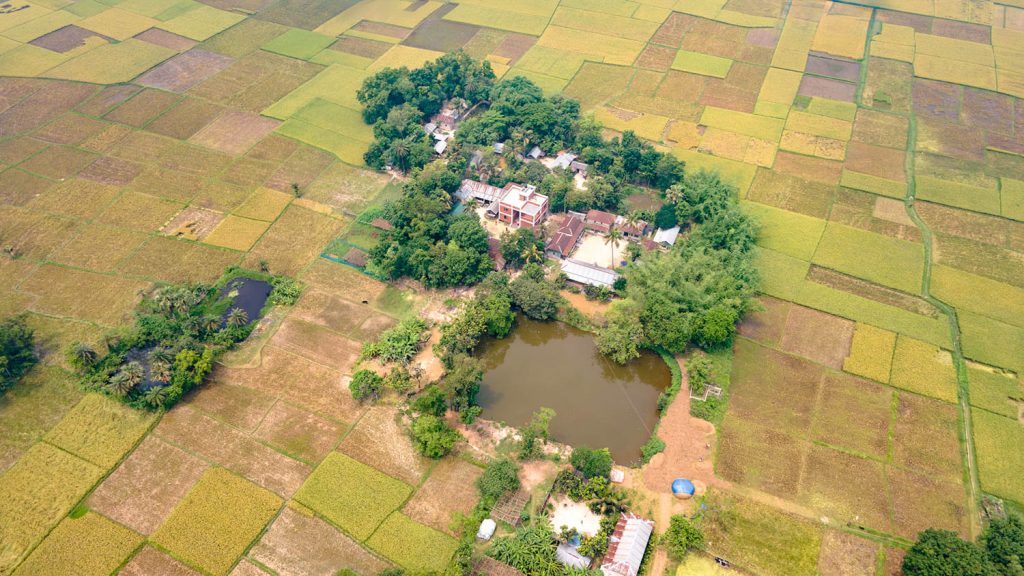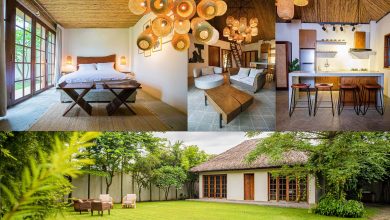In the tranquil village of Kachina, Bhaluka, surrounded by paddy fields and murmuring breezes, a modest yet deeply poetic residence stands—Kabber Ghor. Designed by Design Works Studio (DWS) under the direction of Lead Architect Rokonuzzaman Fakir, the house reflects a thoughtful synthesis of local materials, environmental wisdom, and contemporary sensibility. Far from being a monument to modernity, Kabber Ghor is a meditation on dwelling—on how architecture can exist quietly, in dialogue with its land, light, and people.

The 111-square-meter residence sits amid a rural landscape defined by tin sheds, lush greenery, and the soft horizontality of agrarian life. The surrounding terrain is flat, open, and exposed to Bangladesh’s characteristic monsoon climate—scorching heat in summer, heavy rainfall, and high humidity throughout much of the year.
Against this backdrop, Kabber Ghor emerges as a grounded response to its environment. Rather than imposing a foreign form, the building nestles into the site, its low-slung profile mirroring the rhythm of nearby rooftops. The design language respects the rural vernacular, yet reinterprets it through a refined architectural lens. The resulting form feels both familiar and refreshingly new—a structure that belongs, without trying too hard to announce itself.

At the core of Kabber Ghor’s identity is its brickwork—locally sourced, warm, and textured. Brick here is not merely a construction material; it is an instrument of atmosphere. The architects use it in two primary ways: as a solid mass and as a porous screen.
The perforated brick walls, in particular, lend the house its quiet magic. These screens blur the boundary between inside and outside, allowing air to circulate freely while filtering sunlight into a soft, dappled glow. Throughout the day, shifting patterns of light and shadow animate the walls, bringing movement to what might otherwise seem static. These perforations—meticulously arranged and rhythmically composed—are both practical and poetic.

Beyond their visual beauty, they serve a climatic function, promoting natural ventilation and thermal comfort. The walls act as breathable membranes—shielding against glare and heat, yet remaining permeable to breeze and filtered light.
Complementing the brick is exposed concrete, used for slabs, columns, and floors. Together, the two materials create a tactile and tonal harmony: the earthy warmth of brick set against the cool solidity of concrete. The result is an architecture that feels grounded and honest—one that celebrates imperfection, texture, and the slow patina of time.

Stepping into Kabber Ghor, one encounters a carefully orchestrated play of openness and enclosure. The layout unfolds in layers—public spaces on the ground floor and private areas above—linked by generous vertical circulation. The stairwell acts as a shaft of light and movement, drawing natural illumination deep into the house.
Skylights punctuate the roof, allowing sunlight to pour in from above, while strategically placed openings bring the outdoors inward. During the day, artificial lighting is almost unnecessary; the interiors glow with ambient daylight that changes character as hours pass.
The spatial composition relies on volume rather than decoration. Double-height voids, open corridors, and framed views create a sense of breathing room within a compact footprint. The architecture’s beauty lies not in ornament but in proportion, in how each space expands, narrows, and connects with another.
True to DWS’s design ethos, Kabber Ghor demonstrates how climatic responsiveness can be seamlessly woven into aesthetics. The building operates as a passive system that minimizes energy use and maximizes comfort through design rather than technology.
Natural cross-ventilation, enabled by the perforated façade and strategically placed windows, keeps the interior cool even during the hottest months. The thermal mass of brick and concrete helps stabilize indoor temperatures—absorbing heat during the day and releasing it at night. Extended roof overhangs and shaded verandas protect against direct sun and driving rain.
Rainwater is directed away from the foundation through subtle site grading, while vegetation around the house further tempers the microclimate. The entire structure becomes a living organism—breathing, shading, adapting, and evolving with the seasons.
Perhaps the most remarkable quality of Kabber Ghor is its restraint. It avoids extravagance in both form and finish. Every line, joint, and surface feels deliberate yet unpretentious. The raw material palette—unpainted brick, exposed concrete, and wood accents—remains true to its nature, aging gracefully with time.
Inside, the spaces feel calm and contemplative. The perforated walls diffuse the external noise of the village, creating a cocoon of serenity. The interiors are intimate but not confined; light and air are constant companions.

The design balances privacy and openness, offering framed glimpses of the surrounding greenery while maintaining a sense of inward focus. There’s an emotional honesty in its architecture—one that doesn’t rely on grandeur to evoke beauty but finds it in light, proportion, and the gentle tactility of brick.
The name Kabber Ghor carries affection—it’s named after the youngest member of the client’s family, giving the house an identity rooted in memory and belonging. This sense of intimacy resonates throughout the project. Every element seems to have been considered not only for how it performs but how it feels to live with.

The result is a home that functions as a retreat—a place to reconnect with nature and simplicity without sacrificing comfort or dignity. It embodies an architecture of empathy, one that prioritizes human experience over visual spectacle.
Kabber Ghor offers a compelling case for how contemporary rural architecture in Bangladesh can evolve without erasing its roots. Its lessons are both local and universal:
- Context before concept. The building grows from the land rather than being imposed upon it.
- Material honesty. Brick and concrete are used for what they are, not what they can imitate.
- Light as material. Daylight is treated as a sculptural element, shaping the atmosphere of every room.
- Climate as teacher. The design learns from its environment rather than fighting it.
In an age where architectural expression often leans toward spectacle, Kabber Ghor reclaims the power of subtlety. It reminds us that restraint can be radical, that humility can be luxurious, and that architecture, at its best, is not about objecthood but experience.

Kabber Ghor stands as a quiet testament to architecture’s ability to listen—to its site, its users, and the climate that enfolds it. Rokonuzzaman Fakir and the team at Design Works Studio have crafted more than a rural residence; they’ve created a living, breathing structure that feels deeply human.

In its interplay of brick and light, air and enclosure, Kabber Ghor transcends its modest size. It becomes a metaphor for harmony—between tradition and modernity, nature and shelter, permanence and change.
At a time when much of the built world grows louder, Kabber Ghor’s whisper feels profound. It teaches us that sometimes, architecture doesn’t need to dominate the landscape to define it—it only needs to belong.



